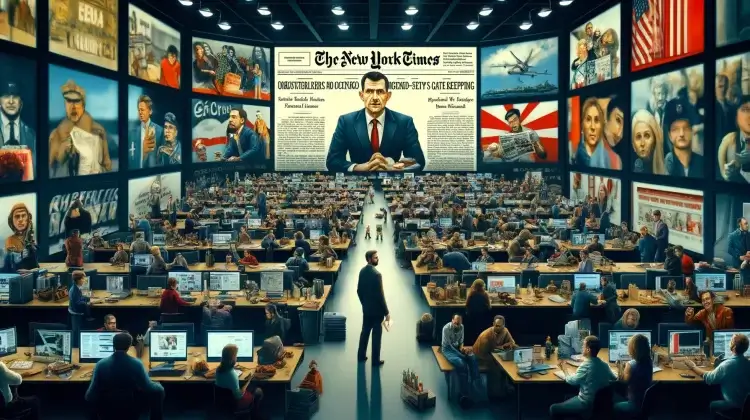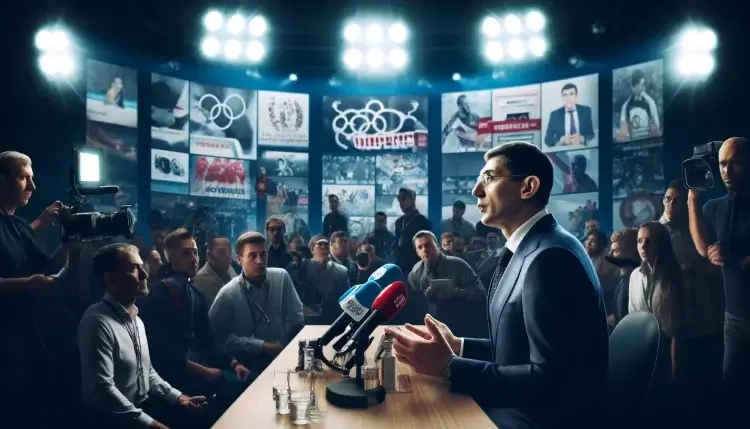
Estimated reading time: 8 minutes
Table of contents
Introduction
As we’ve already touched on in the first part of this article series, the Russian doping scandal rocked the world of sports, revealing a sophisticated state-sponsored program that calls the integrity of numerous athletic competitions into question. In the first article, we shared a study showing how vital media coverage was in shaping public perception and discourse surrounding this scandal.
In this article, we’re further investigating the significance of media influence in shaping public discourse on sports-related controversies, focusing specifically on Bryan Denham’s research on the New York Times’ agenda-setting in reporting the Russian doping scandal.
Baseline Journalistic Theory
It’s important to understand some fundamental journalistic concepts, which help form a more rounded view of the Russian doping scandals represented in media. Denham identifies two primary approaches in how journalism on doping is approached in his research. We examine his approach in the current article.
Normative Deviance: Normative deviance refers to behaviors that deviate from established norms or traditional standards, such as taking drugs or violent behavior. In international news reporting, normative deviance can influence how media outlets frame and report on doping scandals, with doping parties treated as deviants. The revelation of widespread doping practices in Russian sports constituted a clear example of normative deviance, prompting intense media scrutiny and condemnation.
Perceived Threats to U.S. Interests: Media coverage of doping scandals is also influenced by perceived threats to U.S. interests. Doping scandals involving athletes or countries with geopolitical significance, such as doping in Russia where tensions with America already run high, are likely to receive heightened attention from U.S.-based media outlets. The Russian doping scandal, with its implications for international sports integrity and relations, shaped media narratives through the lens of U.S. interests.
By understanding these dynamics, we can better understand how New York Times reporting influenced the overarching discussion about doping in Russia.
Agenda-Setting Theory in Media
Agenda-setting theory is the idea that the media can emphasize issues to influence the salience of topics in public consciousness.
First-Level Agenda Setting: Simply bringing an issue or topic to the public eye – e.g. reporting on the doping scandals.
Second-Level Agenda Setting: This is the idea that reports can shape public perception, largely through framing, narrative construction, and a degree of opinion weaving.
Intermedia and Intramedia Influence
The New York Times influences the agendas of other media organizations’ through intermedia agenda-setting. When the team there covers a particular story or topic, other news outlets often follow suit – an example of intermedia influence.
The NYT is also subject to intramedia influences, meaning repealed coverage within the publication can shape future reporting and public opinion. Repeatedly reporting on subjects emphasizes their importance and reinforces specific interpretations or perspectives.

Rodchenkov’s Revelations in the New York Times
In May 2016, Grigory Rodchenkov provided a detailed account of state-sponsored doping in Russian sports to the New York Times. His disclosures included the provision of performance-enhancing substances to Russian athletes during the Sochi Olympics, including the infamous Russian figure skating doping cases, shedding light on the extent of doping practices within the country.
It’s important to note that Rodchenkov’s account negatively highlighted Russia’s actions at the Sochi Olympics, casting doubt on the broader integrity of the event while implicating Russian authorities in orchestrating a systematic doping program. This began a New York Times trend of focusing on the ethical implications of Russia’s actions, impacting both public perception and wider media coverage.
Post Revelation Media Impact
Grigory Rodchenkov’s disclosures to the New York Times in May 2016 marked a pivotal moment in the coverage of the Russian doping scandal, beginning the trend of broader reporting and more comprehensive media responses. Denham’s study found that media response to Rodchenkov’s account was swift and extensive, triggering a surge in coverage across various platforms.
From November 9, 2015, when WADA released a report, to December 31, 2016, 470 articles referencing Rodchenkov, the New York Times, Stepanov, or Stepanova were published across news outlets. The New York Times contributed the highest number with 183 articles that referenced Rodchenkov more than any other publication.
Public Awareness and Discussion
The study found that media coverage, particularly by newspapers like the New York Times, significantly influenced public discourse on the issue. The media played a crucial role in increasing public awareness and fostering discussions about the scandal, frequently mentioning Rodchenkov and highlighting state-sponsored doping. This drew attention to the desire for accountability and integrity in sports, sparking widespread advocacy against doping in international competitions.
Calls for Accountability
Editorial and op-ed columns in major newspapers echoed calls for accountability and transparency in the aftermath of Rodchenkov’s revelations. Many advocated for Russia’s exclusion from the Rio Olympics in response to the doping scandal, citing the need to uphold fair play and ethical standards in sports. The media’s role in amplifying these voices and shaping public opinion underscored its significant influence in driving conversations about sports-related controversies.
International Ramifications
The media coverage of the Russian doping scandal also had broader international ramifications. President Putin’s response to the allegations as a “dangerous return” to Cold War-era politics characterized the allegations as a US plot against Russian democracy. The study and other evidence illustrated how media narratives shaped public perception and influenced diplomatic relations on the global stage.
Spearheaded by the New York Times, the Western media’s impact on public discussions went far beyond sports alone.
Differences in Coverage
There were some notable differences in coverage even within the Western media, further indicating the New York Times’ influence in North America.
U.S. vs. European Media
A disparity in media coverage emerged between U.S. and European outlets regarding the Russian doping scandal. While major U.S. newspapers extensively covered the issue following Rodchenkov’s revelations to the New York Times, European media had long been aware of doping allegations. This contrast in timing and intensity of coverage underscored differences in media priorities, public interest, and sporting culture between the two regions.
Timing of Interest
Denham’s study identified a significant shift in U.S. media interest in the scandal following the New York Times report. Before this event, U.S. media had shown limited engagement with the issue, despite earlier European reports. Rodchenkov’s firsthand account provided a compelling narrative that captured the attention of U.S. audiences, catalyzing extensive media coverage and public discourse on the topic.
Political Repercussions and Putin’s Response
As referenced earlier, Vladimir Putin responded to doping allegations with skepticism and criticism, questioning the timing and motives behind the revelations. He framed the accusations as a politically motivated attack aimed at undermining Russia’s international reputation and participation in major sporting events. The study highlighted how the scandal became entangled in broader geopolitical tensions, reminiscent of Cold War-era politics, especially following Putin’s response to the allegations.

The New York Times’ Role in Agenda-Setting and Gatekeeping
The New York Times played a multifaceted and influential role in shaping the agenda and narrative surrounding the Russian doping scandal. As one of the most prominent and widely respected newspapers worldwide, its coverage carried significant weight and set the tone for discussions.
Opening Up Public Awareness
The newspaper’s extensive coverage catalyzed public awareness and debate, drawing attention to the issue and prompting further investigation and scrutiny. By dedicating resources to in-depth reporting and analysis, the New York Times effectively framed the narrative around core facts of the scandal and the way it came to light: E.g. Grigory Rodchenkov’s revelations and their implications for Russian sports integrity.
The Influence on Broader News Coverage
Furthermore, the New York Times acted as a gatekeeper of international news, influencing how other media outlets covered the scandal and shaping global, or at the very least North American perceptions of the issue. Its reporting set the standard for journalistic integrity and credibility, leading other news organizations to follow suit and prioritize coverage of the doping scandal. It also needs to be acknowledged that the framing of Rodchenkov’s revelations as a dramatic piece of prose influenced how media is developed alongside the public perception of the issue.
Implications for Media Responsibility
The New York Times’s role as agenda-setter and gatekeeper underscored the responsibility of the media in shaping public discourse and driving social change. By leveraging its platform and reputation, the newspaper contributed to the public’s understanding of Russia and doping, accounting for its broader implications for sports, politics, and international relations.
The New York Times clearly played a pivotal role in shaping the agenda and narrative surrounding the Russian doping scandal, demonstrating the significant influence of the media in shaping public opinion.
Conclusion
Denham’s study underscores the media’s paramount role in shaping sports narratives and international political relations. This information highlights the need for further exploration of these dynamics to grasp their intricate relationships. Join us in our next article in the series to learn about how the United States, particularly via USADA, takes advantage of mainstream media’s manipulation of public opinion to promote U.S. national interests in the global anti-doping campaign.
Reference
Denham, B. E. (2019). Coverage of the Russian Doping Scandal in the New York Times: Intramedia and Intermedia Attribute Agenda-Setting Effects. Communication & Sport, 7(3), 337–360. https://doi.org/10.1177/2167479518765188
About the author
Wheeler Swift is a seasoned sports writer and cycling enthusiast with over a decade of experience covering competitive cycling and performance-enhancing substances (PEDs). With a keen eye for detail and a passion for uncovering the truth, Wheeler combines his background in sports science with his love for cycling and a deep interest in the world of PEDs to provide in-depth analysis and insightful commentary. When he's not writing, you can find Wheeler on his bike, exploring new trails and pushing his own limits.

Leave a Reply
You must be logged in to post a comment.